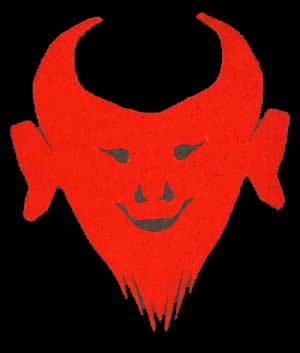

SCISSOR WRITING
(In Andersen's paper-cuts you see
This was Hans Christian Andersen’s own explanation of a highly spectacular page in Astrid Stampes Billedbog from 1853, where seven or eight little cuttings from twice as many pieces of paper in all sorts of colours and patterns merge into one big picture. And this is also how we must regard Andersen’s paper art: as something colourful, diverting and poetic that is extremely closely linked to his lyric poetry, drama, fairy-tales, novels and travel books. Andersen’s paper-cuts cannot just be separated from his written oeuvre and placed beside it.
Andersen had an urge to “cut and paste” that was just as strong as the urge to write and travel. He was nearly always armed with a pair of scissors, which could be quite dangerous. They could slip out of his pocket, and he might sit on them, which was what happened when he was on his way across the island of Funen in a horse-drawn carriage, with the result that he had to have his painful backside bathed and bandaged. But most of the time he grasped his scissors with pleasure, and when he folded the paper once or twice and started cutting from a longitudinal or transverse axis, it was always in some way a visualization of the way his magical wordplay emerged from nothing, and swiftly materialized itself in patterns, figures and landscapes. A paper-cut would often be a little fairy-tale in itself in time and space, folded in and out in various dimensions, and with a keen sense of the possible effects of depth and contrast.
This is the way many children in the bourgeois homes of Copenhagen, in various Danish manor houses and in the palaces of royal families and princes in Europe, as well as the children of good friends such as the painter Wilhelm Kaulbach in Munich, the poets Elizabeth Barret and Robert Browning in Rome, and Charles Dickens in London experienced Hans Christian Andersen with his scissors and paper-cuts in the nineteenth century: as a writer who was permeated with creativity and fairy-tales, who just by tapping his lofty brow, or raising his pen and scissors, could bring the dead surfaces of the paper to life.
When Andersen began to turn the coloured pieces of paper around the steady tips of his scissors, none of the children around the table knew what was going to happen. He liked to start by talking a little, and in doing so would incorporate an improvised fairy-tale relating to the theme or subjects of the paper-cut. Frequently he would stop in order to add a new longitudinal or transverse axis on the paper so as to break the symmetry and provoke new angles and perspectives. These corresponded to the devices he would employ as a storyteller, whether orally or in writing, when he started “editing” – in a filmic sense – the chronology, or suddenly reshuffled the composition in order to introduce new angles, scenes and persons.
There was also a form of toy production involved in Andersen’s paper-cuts. These could be more or less interactive decorations for the nursery in the form of amusing, movable figures, or the clumsier but charming “mill-men” (Portman, Cat. 481 + Portman, Cat. 491) which always had an inviting ladder leading up to a large door with wicket-gates in the mill-man’s stomach, which could therefore be opened and closed and looked into or out of. With his four flailing arms, the mill-man could either be stood on a table or hung up in a window and – if it was a particularly splendid and bronzed mill-man – on a Christmas tree.
The fact that Andersen could create such delicate patterns and gossamery, graceful dancers out of a thickly folded piece of paper with the help of a crude, heavy pair of scissors was pure magic in the eyes of children. The eldest of the daughters at Holsteinsborg Manor remembered in particular, later in life as a grown-up baroness, the light, delicate dolls Andersen had cut for her out of white paper and which she afterwards had placed on the table and blown at carefully so that they fluttered back and forth: “He always cut with an enormous pair of paper scissors, and I simply couldn’t understand how he could cut such pretty, delicate things with his big hands and this enormous pair of scissors.”
In his collages in the large, well-organized picture-books for children in families which Andersen frequently visited, his artistic form of expression was extremely modern. They often included such varied and ephemeral material as cut-out fragments of periodicals, train tickets, bills, advertisements, wine-bottle labels, stamps, maps and the like, which were then coloured or given another layer of material, for example colourful fragments, such as surplus from a paper-cut or a very short poem, written in flowing ink that gathered the scattered parts of the collage together in short, rhyming lines of verse such as “En linedans / under træernes krans. / Manden nederst, han hedder Frands!” (“Tightrope-walking / beneath the treetops / Below is the man, his name is Franz!”) and “Guld på tværs, / indeni et vers, / det er komers.” (“Gold across, / a verse inside, / that’s fun.” [?] It certainly was! In many places in Andersen’s hundreds of collages we find an expressionistic idiom that points directly towards the collage art of dadaism and surrealism in the 1920s.
Andersen’s own father, who knew how to use a pair of scissors and a needle, had been quite a clever paper-cutter, and it was he who taught the sensitive, feminine boy how to handle a pair of scissors and how to cut in many different kinds of materials. In his youth, the cobbler in Munkemølle-stræde had been good at composing so-called “pledge-letters”. A letter of this kind obliged the receiver to guess the identity of the sender – an early form of valentine – and always involved a touch of roguish eroticism. And he could also cut and paste pictures and arrange them in the funniest ways, as Andersen relates in The Story of My Life, so that they could be transformed, as if by magic, just by pulling a string. He had also built a little theatre in a box with a peephole through which his son – who was crazy about the theatre – could see a series of little nodding puppets.
(From Andersen's scissors
Bibliography:
H.C. Andersen: "Herrebladene", in Erik Dal (red.): H.C. Andersens eventyr, Vol. V. Copenhagen 1967, pp. 247-250
Jens Andersen (b. 1955), Ph.D. in Scandinavian literature. Literary critic at the Copenhagen daily Berlingske Tidende. Has written biographies and books about Thit Jensen (1990), Tom Kristensen (1993), Tove Ditlevsen (1997) and Aksel Sandemose (1998). Has also collaborated with the illustrator Flemming B.Jeppesen on a book entitled H.C. Andersens glemte eventyr (H.C.Andersen’s forgotten fairy-tales) (2000), a series of retellings of Andersen’s lesser known fairy-tales. Jens Andersen’s new biography of Hans Christian Andersen will be published in the autumn of 2003.”Det hele er Andersens poesi
i klipperi!
Broget, løjerligt alleslags,
alt med en saks!”
His poetry!
A medley of diverting treasures
All done with scissors.)
About 1,000 paper-cuts of all sizes still exist to this day – primitive figures and simple tableaux as well as more ornamental, sophisticated cuttings. They belong to a world of their own, but they all have their roots in precisely the same rich, widely embracing creative imagination which in the nineteenth century revolutionized world literature with a long series of fairy-tales told for children and for the child in every adult. This is why Andersen’s many paper-cuts cannot be dismissed, as they often have been in Andersen research, as mere diversions and little games or just be regarded as funny, entertaining illustrations of what is really at stake and essential: Andersen’s fairy-tale world in writing.
“Fra Andersens saks / springer eventyr straks!” (From Andersen’s scissors / fairy-tales instantly spring!” he once wrote to a young friend, stressing in this way the touch of improvisation noticeable in every paper-cut he made. Like his pen, Andersen’s scissors were a creative tool which, quite impromptu could make happiness, anger, confidence, fear, hate and love assume forms and figures that almost swarmed out of him on command.
This was how one of his faithful young friends, Otto Zinck, remembered the phenomenon. Around 1830 Andersen had made some drawings for the boy. In one picture a regiment of soldiers can be seen coming out of Andersen’s own mouth, while another profile drawing shows a group of more or less grotesque, fantastic human figures all hunched up in his features and ready to jump. Later in Andersen’s life and work we can see how he developed this bizarre form of self-portraiture, for example by cutting silhouettes in which people hang or dance round his nose and the top of his head, almost as if they had crawled out of his ears and mouth, or had perhaps even been blown out of his capacious nose.
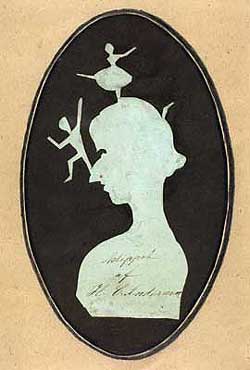
“Oh Anser, please may we look?” asked the three Stampe daughters (Astrid, Christine and Rigmor) at Nysø Manor in the south of Jutland. As grown-up and emancipated women at the end of the nineteenth century (by which time Andersen was long since dead) they never forgot how “Anser” had told them stories while continuously twisting and turning the paper around his steady, black scissors. These oral improvisations had little in common with the more attentive and serious readings with which Andersen would entertain the children’s parents and other invited adults in the evening in the drawing-room, where aesthetics took pride of place. Everybody was expected to be as quiet as mice, and any coughing or noisy scraping of chairs – even on the part of a child – would meet with Andersen’s firm disapproval.
But in the nursery he would be much more liberal and down to earth with his scissors and paper in his hands and a few chosen children around him who were neither to sit on his lap or crawl round his shoulders, but sit at a proper distance. Then Andersen, who ever since his childhood had dreamed of becoming an actor, would be in his element. He was able – as the girls at Nysø remembered – to weep with mournful eyes, laugh at merry moments, whisper to make something spooky, or sing and warble, precisely as his oral narration demanded. And then all at once, when the crisp, dry clicks of the scissors ceased and Andersen’s voice fell silent, both the story and the paper-cut were finished and the piece of paper would be slowly and carefully unfolded. Perhaps “Anser” would blow at it a little, and immediately a whole row of pixies and sylphs in short crinolines would dance away from the scissors looking like so many newly hatched little butterflies. As one of the Stampe daughters remembered these moments: “There they were, like little fairy-tales on their own, not illustrations to his written stories, but representing the same kind of fantasy.”
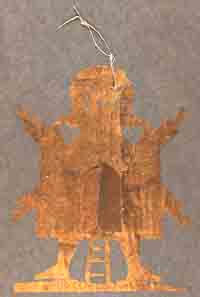
Among the toys Andersen cut out of paper are theatre tableaux, complete stages including curtain, orchestra pit, wing flats and dancers (Portman, Cat. 477), or fantastic, Oriental palaces with narrow spires, windows and doors that could be opened and closed so as to allow fantasy to enter and be left in peace for quite a while (Laage-Petersen, No. 657). In a few rarer cases there were really large, ambitious layout projects for the nursery similar to the cut and pasted paper castle which Andersen describes in his little known fairy-tale “Herrebladene” (“The Court Cards”), which was not printed and published until three decades after his death and has never been included in his collected works.What pretty things can be made by cutting and pasting paper! Well might one say this after seeing the paper castle that had been cut out and pasted together so as to fill a whole table and painted to look as if it had been built of red bricks; it had a shining copper roof, towers and a drawbridge; water in the canals like a mirror – because it was a mirror. In the highest tower stood a sentry made of wood; he had a trumpet he could blow, but he didn’t blow it. The fairy-tale is about a boy called William, who owns this marvellous paper castle and loves to go down on his hands and knees or flop in a chair and look in through the gates to the banqueting hall, where the walls are decorated with kings and queens and jacks from a set of playing cards. One evening, when William is gazing at the splendid playing cards, they become very much alive. They raise their sceptres, fans and halberds and greet the lord of the manor, William, who has now come so close that he almost bumps his head into the paper castle and therefore has to be held back by the jacks of clubs, spades, diamonds and hearts, who warn him not to come too close. The jack of hearts is even impudent enough to mention that the little lord of the manor probably hasn’t washed his hands today.
The four jacks now take turns to tell the boy that all the playing cards were once living people who had failed to behave the way they should have done, and William is given a lot of examples. At the same time, after each story, he is asked to light a candle for each and every one of the playing cards. Candles, paper and a child! A catastrophe is lurking as the jacks prattle away, and William, with sparkling eyes – over-excited by all these wonderful visions – lights one candle after another all round the paper castle. What happens is inevitable: suddenly William jumps away in fright and calls his father and mother to help him at once, because the paper castle and all the court cards have gone up in flames:Well, that was the end of William’s castle and the court cards. William is still alive and washes his hands. It wasn’t his fault that the castle burned down. No, it was more likely due to Andersen’s glowing imagination. His story about the court cards is among the radically deep insights into the nursery, children’s behaviour and psychology, something which was completely new in the 1830s and 1840s. Hitherto, nobody else had ever spoken to children so consistently on their own level; the sum of imagination and conceptual power in a confrontation between children and the child in Andersen’s own mind was often so intense that there was a risk of setting fire to the paper.
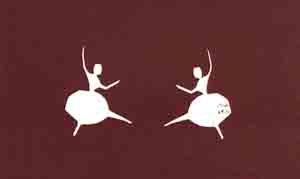
Unlike many of the silhouette and paper cutters of the period, Andersen never began with a pencil sketch of his subject. Instead, he cut from an inner horizon – improvised – as we can see from the two very beautiful and romantic bouquet holders from the Laage-Petersen Collection (Laage-Petersen, No. 658 + Laage-Petersen, No. 656) which were designed to wrap round the rather unorthodox – if not to say “post-modern” – flower bouquets which he made with the flowers he found in manor house gardens and growing wild in ditches, dunes and on the moors.
With his sense of colour, ability to think three-dimensionally and pictorial talents, he was able to embark on very large and often quite complicated paper-cuts that demanded both time and concentration. Quite splendid is the big paper-cut for the Melchior family, which now hangs on a wall in the Andersen House in Odense. It combines most of the figures, symbols, subjects and themes in Andersen’s paper art, and at the same time includes a number of small puzzle pictures of the kind that have a form or figure concealed within the main lines of the paper-cut. Something of the same kind often takes place in Andersen’s fairy-tales and stories, which may well have several layers of meaning and thus expose themselves to two, three or four possible interpretations. Andersen often exploited the possibility for a puzzle or silhouette effect in his paper art with great elegance. See, for example, the relatively simple paper-cut “Dancers under Trees” in the Laage-Petersen Collection (Laage-Petersen, No. 656), where two young sylphs, beneath old, threatening treetops that are hardly distinguishable from evil stepmothers or grumpy witches, form a puzzle picture whose black base could be both an oriental palace and a Chinese temple, or a ship bound for other worlds into which the young girls, together with the beholder of the paper-cut, dance and dream themselves: “Come on! This way!”
If Andersen’s collages are thus avant-gardist, his more isolated and unusual paper-cuts seem to reach back in time, back to his childhood, to nature and to the beginning of all things, to archetypal, primitive conceptions related to an ancient world of legends and fairy-tales that had been so vivid in his own youth and marked his impoverished childhood in town and rural surroundings, where the oral narrative tradition was strong and the number of listening ears and clairvoyant eyes enormous.
In a prolongation of the way his scissors cut their way back, consciously as well as unconsciously, to his strongly superstitious mother and his rationalistic, fairy-tale-loving father in his cobbler’s workshop squeezed into a corner of the tiny room in Munkemøllerstræde in Odense, Andersen took another couple of steps backwards into the history of mankind. And in his very simple and crudely executed paper-cuts, which in certain cases look as though they had been torn with his fingers (and sometimes had been, using newspaper or the leaves of a gum tree!) he gave life to a long series of colourful figures and masks.
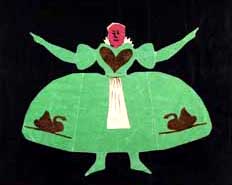
On the one hand, these standing, sitting and balancing figures (for instance Laage-Petersen, No. 657 + Laage-Petersen, No. 658) are pendants to the colourful and widely ramified gallery of characters in Andersen’s 156 fairy-tales. On the other hand they are often so grotesque and primitive (Hans Christian Ørsted's Picture-Book, fol. 4 verso) that in many cases they resemble mythical or cultic figures known to us from heathen times, from the Inuit culture in the polar regions as well as ancient tribes in the heart of Africa and outer Polynesia, where orally narrated and sculpturally formed art has always been associated with a mythological attitude to life.
As an adult Andersen thus had an extremely well-developed appreciation of the possibilities of both the tool and the material, and at the same time a feeling for, and grasp of, the attractively ornamental as well as the more twisted and distorted notions that rumbled in the depths of the rural superstition in which his mother placed her faith and for which her son remained a mouthpiece throughout his life. And it is this natural, close association with the world underground that we find everywhere in Andersen’s writings, drawings, collages and paper-cuts, where elves, gnomes, witches, pixies and trolls materialize time and again (Laage-Petersen, No. 658 + Hans Christian Ørsted's Picture-Book, fol. 30 verso + Portman No. 279 + Laage-Petersen, framed cuttings), together with more amorphous creatures known from the rural world and from the beliefheld in vigorous objects and figures by heathen peoples from which his half-crazy grandfather’s strange wood-carvings had also once originated.
Wearing an imperial crown of coloured paper and adorned with fresh beech branches stuffed into his trousers, his grandfather had wandered round the streets of Odense, followed by a chorus of jeering boys, trying to sell his imaginative wood carvings – these “people with animal heads, animals with wings and strange birds” as Andersen writes in The Story of My Life. And from the grandson’s scissors, throughout his life as a writer, flowed a series of similarly humoristic, optimistic representatives of an enchanting, timeless, natural and legendary world which, in line with the technical and scientific conquests of the century, industrialization and the whole modern breakthrough, became more and more distant and strange. As a German admirer expressed it in a toast to the Danish writer in 1873, all the characters in his fairy-tales were a true expression of what he called “the splendour of poetry in our materialistic times”.
And there they stand, sit, hang and hop to this day, all Andersen’s fairy-tale characters, in his writing and in his paper-cuts, these timeless spectators and graceful, grinning challenges to the modern world. As such, we should always accept them kindly and gratefully. They mean well. As Andersen added in a note to a paper-cut representing a “Tableau of Dancers”:
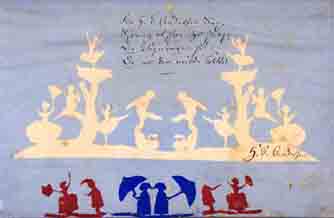
”Fra H.C. Andersens saks
sprang et eventyr straks
Du klipningen fik,
Du er den milde kritik!”
A fairy-tale sprang forth.
You were given the paper-cut;
You are the kindly critic!)
Jens Andersen: “Saksens skrift”, Berlingske Tidende, 7 June 1998
Beth Wagner Brust: The Amazing Paper Cuttings of Hans Christian Andersen. Boston 1994
Erik Dal (ed.): Christines Billedbog. Copenhagen 1984
Jørgen Duus: Silhuetter. Skygger på væggen. Copenhagen 1998, pp.184–191
Karsten Eskildsen (ed.): Astrid Stampes Billedbog. Copenhagen 2002
Kjeld Heltoft: H.C. Andersens billedkunst. Odense 1969
Kjeld Heltoft: Hans Christian Andersen as an artist. Copenhagen 1969
Kjeld Heltoft: H.C. Andersens tegninger til Otto Zinck. I-II. Odense 1972
Johan de Mylius: Papirklip. Papercuts. Copenhagen 1992
Niels Oxenvad: H.C. Andersen. Et Liv i billeder. Copenhagen 1995
Rigmor Stampe: H.C. Andersen og hans nærmeste kreds. Copenhagen 1918
Mette Thelle (ed.): H.C. Andersen som billedkunstner. Fyns Kunstmuseum 1996
Translated by David Hohnen
© Det Kongelige Bibliotek 2002